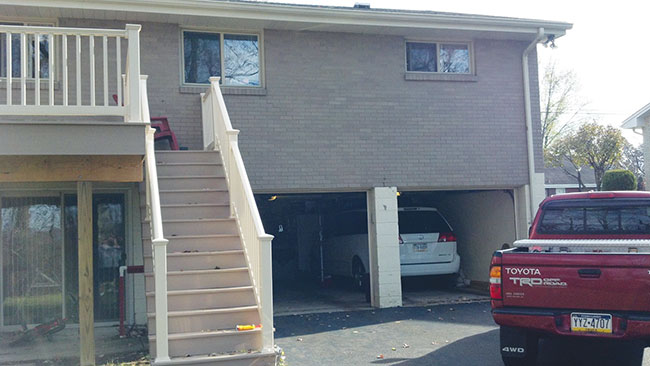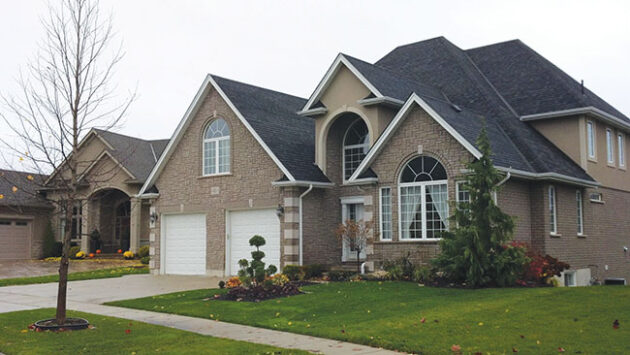
Features
Back to Basics: Garage fires, Part 2
March 23, 2023
By
Mark van
 Photo 1: The garage located is in the lower part of the house, forming a part of the basement
Photos by Mark van der Feyst
Photo 1: The garage located is in the lower part of the house, forming a part of the basement
Photos by Mark van der Feyst In our continued look at garage fires, we are progressing to examine the fire dangers that are commonly found within garages. This danger starts with the growth of the fire within a garage.
A garage is not just dangerous based upon the contents; it’s also dangerous based upon the location of the garage in contrast to the residential structure. If you recall from our previous article in February, we highlighted different locations of where a garage can be located within a structure.
In the case of Photo 1, you can see the garage located in the lower part of the house – it actually forms a part of the basement. With the garage located in bottom of the structure, a garage fire will spread very quickly upward towards where the occupants are located.
As in the case of a garage located on the main level of a residential structure with sleeping quarters located above it, the same case applies.
With the garage located on the side of the residence such as with a ranch or bungalow type of house, the spread of the fire will be quick, but not as quick as when the garage is right below the area where occupants are located. The main area of fire will be above in the attic of the structure with horizontal spread into the living areas.
Another factor to consider is the height of the garage. As with the interior compartments of a residential structure, fire spread is dictated by the height or size of the room. In the case of a garage like in Photo 1, the height is very low compared to a garage that may house a recreational vehicle. With a low celling garage, the fire spread will be very quick. In our same photo, we can also see how this particular garage will present auto exposures to the windows above the garage doors as well cut off escape routes out the back with the deck stairs.
With fire growth dangers, we must also include the construction properties of the garage. In Photo 2, you will see an example of a garage that will include certain construction properties that will lend into quick fire spread due to items such as lightweight trusses. Notice the window above the garage door and the slope and height of the roof line. Designed to allow for a bonus room above the garage or a large area for storage. To accommodate this, lightweight trusses will be used to meet the large span and the height. Along with lightweight trusses, we can also find laminated I-beams being used. These also allow for large spans and heights to be accomplished. Just as mentioned in the previous paragraphs, with a living space located right above the garage, the danger of quick fire spread will impose a threat to escape routes and auto exposure.
What may assist with the slowing spread of fire lies within our building codes. Fire stops are supposed to be installed within the garage at the ceiling and walls leading into the living side of the residence. This is supposed to be a one-hour fire stop using 5/8 inch drywall or two sheets of ½ inch drywall. The drywall is to be tapped and mudded to prevent any breaks for fire spread as well as carbon monoxide leaking in from the garage.

Photo 2: This garage features certain construction properties that lend into quick fire spread.
A brand-new house being constructed will have this as it will be inspected by the local building inspector before getting the permit issued. Where we may find a danger with this is when there are renovations done inside the garage and there are holes made in the ceiling or wall that are not patched up as required.
With older homes, where the building code was not the same as it is currently, the separation between the garage and living spaces may not be the same leading to a easily penetrable barrier for the fire to grow and spread.
In contrast to what dangers are with the construction properties and location of the garage, we also must consider what is outside and around the garage that may also present a danger. The obvious danger will be poor housekeeping around the outside. This can include junk piles of garbage, compressed cylinders, heavy objects, high piles of junk around the outside preventing access to the garage or access around the garage. The piles of junk will also contribute to the external fire load of the garage.
On top of the garage, we may find solar panels affixed to the roof. While this may be a great way to produce energy for the homeowner or a way to heat the water for a pool, it adds more weight to the structure’s roof. The roofs of garages are not designed to be affixed with the right type of trusses to support both the roofing material and the extra weight of solar panels.
On the outside of the garage is also the garage doors – they to are a danger to the fire service. As mentioned in the previous paragraph regarding solar panels, we are now seeing these being installed on the garage door panels – forming the panel itself for the garage. Trying to gain entry through the door will not be possible with these items forming the panel.
What has been detailed here is just a simple approach to what can be present at any garage fire that you may respond to. A good size-up will assist with identifying these outside hazards. In our next issue, we will examine the dangers inside the garage.
Mark van der Feyst has been in the fire service since 1999 and is currently a firefighter with the FGFD. Mark is an international instructor teaching in Canada, U.S. FDIC and India. He is the lead author of Fire Engineering’s Residential Fire Rescue & Tactical Firefighter books. Contact him at Mark@FireStarTraining.com.
Print this page
Advertisement
- Laurier firefighters achieve auto extrication and exterior attacks certification
- Comment: Wildfire season is underway